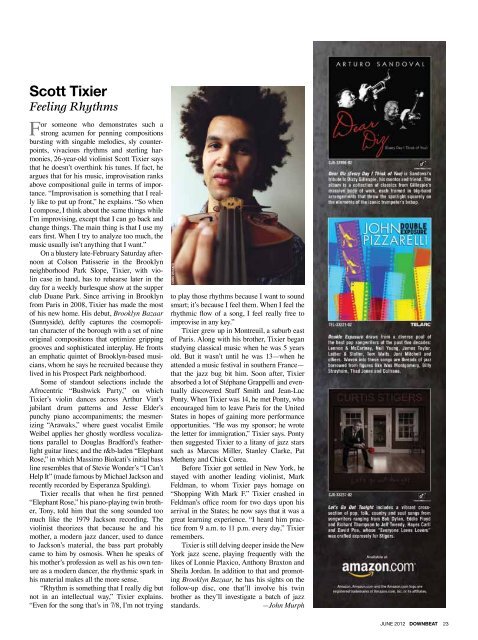Ralph Peterson 35th Annual Student Music Awards - Downbeat
Ralph Peterson 35th Annual Student Music Awards - Downbeat
Ralph Peterson 35th Annual Student Music Awards - Downbeat
You also want an ePaper? Increase the reach of your titles
YUMPU automatically turns print PDFs into web optimized ePapers that Google loves.
Scott tixier<br />
Feeling Rhythms<br />
For someone who demonstrates such a<br />
strong acumen for penning compositions<br />
bursting with singable melodies, sly counterpoints,<br />
vivacious rhythms and sterling harmonies,<br />
26-year-old violinist Scott Tixier says<br />
that he doesn’t overthink his tunes. If fact, he<br />
argues that for his music, improvisation ranks<br />
above compositional guile in terms of importance.<br />
“Improvisation is something that I really<br />
like to put up front,” he explains. “So when<br />
I compose, I think about the same things while<br />
I’m improvising, except that I can go back and<br />
change things. The main thing is that I use my<br />
ears first. When I try to analyze too much, the<br />
music usually isn’t anything that I want.”<br />
On a blustery late-February Saturday afternoon<br />
at Colson Patisserie in the Brooklyn<br />
neighborhood Park Slope, Tixier, with violin<br />
case in hand, has to rehearse later in the<br />
day for a weekly burlesque show at the supper<br />
club Duane Park. Since arriving in Brooklyn<br />
from Paris in 2008, Tixier has made the most<br />
of his new home. His debut, Brooklyn Bazaar<br />
(Sunnyside), deftly captures the cosmopolitan<br />
character of the borough with a set of nine<br />
original compositions that optimize gripping<br />
grooves and sophisticated interplay. He fronts<br />
an emphatic quintet of Brooklyn-based musicians,<br />
whom he says he recruited because they<br />
lived in his Prospect Park neighborhood.<br />
Some of standout selections include the<br />
Afrocentric “Bushwick Party,” on which<br />
Tixier’s violin dances across Arthur Vint’s<br />
jubilant drum patterns and Jesse Elder’s<br />
punchy piano accompaniments; the mesmerizing<br />
“Arawaks,” where guest vocalist Emile<br />
Weibel applies her ghostly wordless vocalizations<br />
parallel to Douglas Bradford’s featherlight<br />
guitar lines; and the r&b-laden “Elephant<br />
Rose,” in which Massimo Biolcati’s initial bass<br />
line resembles that of Stevie Wonder’s “I Can’t<br />
Help It” (made famous by Michael Jackson and<br />
recently recorded by Esperanza Spalding).<br />
Tixier recalls that when he first penned<br />
“Elephant Rose,” his piano-playing twin brother,<br />
Tony, told him that the song sounded too<br />
much like the 1979 Jackson recording. The<br />
violinist theorizes that because he and his<br />
mother, a modern jazz dancer, used to dance<br />
to Jackson’s material, the bass part probably<br />
came to him by osmosis. When he speaks of<br />
his mother’s profession as well as his own tenure<br />
as a modern dancer, the rhythmic spark in<br />
his material makes all the more sense.<br />
“Rhythm is something that I really dig but<br />
not in an intellectual way,” Tixier explains.<br />
“Even for the song that’s in 7/8, I’m not trying<br />
ChRiS dRukkER<br />
to play those rhythms because I want to sound<br />
smart; it’s because I feel them. When I feel the<br />
rhythmic flow of a song, I feel really free to<br />
improvise in any key.”<br />
Tixier grew up in Montreuil, a suburb east<br />
of Paris. Along with his brother, Tixier began<br />
studying classical music when he was 5 years<br />
old. But it wasn’t until he was 13—when he<br />
attended a music festival in southern France—<br />
that the jazz bug bit him. Soon after, Tixier<br />
absorbed a lot of Stéphane Grappelli and eventually<br />
discovered Stuff Smith and Jean-Luc<br />
Ponty. When Tixier was 14, he met Ponty, who<br />
encouraged him to leave Paris for the United<br />
States in hopes of gaining more performance<br />
opportunities. “He was my sponsor; he wrote<br />
the letter for immigration,” Tixier says. Ponty<br />
then suggested Tixier to a litany of jazz stars<br />
such as Marcus Miller, Stanley Clarke, Pat<br />
Metheny and Chick Corea.<br />
Before Tixier got settled in New York, he<br />
stayed with another leading violinist, Mark<br />
Feldman, to whom Tixier pays homage on<br />
“Shopping With Mark F.” Tixier crashed in<br />
Feldman’s office room for two days upon his<br />
arrival in the States; he now says that it was a<br />
great learning experience. “I heard him practice<br />
from 9 a.m. to 11 p.m. every day,” Tixier<br />
remembers.<br />
Tixier is still delving deeper inside the New<br />
York jazz scene, playing frequently with the<br />
likes of Lonnie Plaxico, Anthony Braxton and<br />
Sheila Jordan. In addition to that and promoting<br />
Brooklyn Bazaar, he has his sights on the<br />
follow-up disc, one that’ll involve his twin<br />
brother as they’ll investigate a batch of jazz<br />
standards. —John Murph<br />
JUNE 2012 DoWNBEAt 23

















